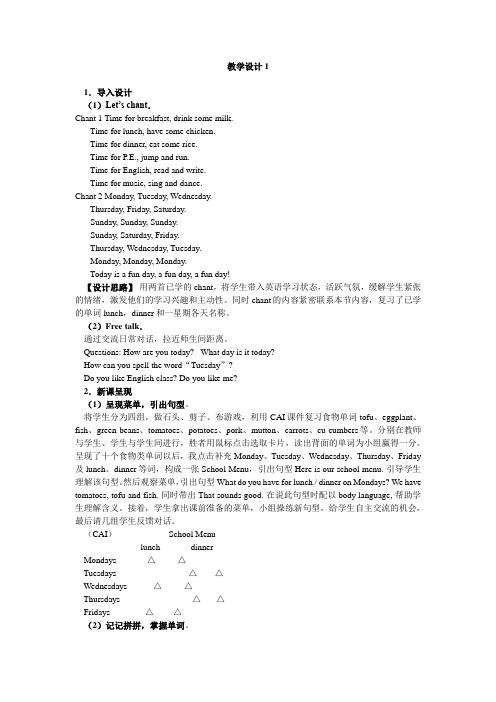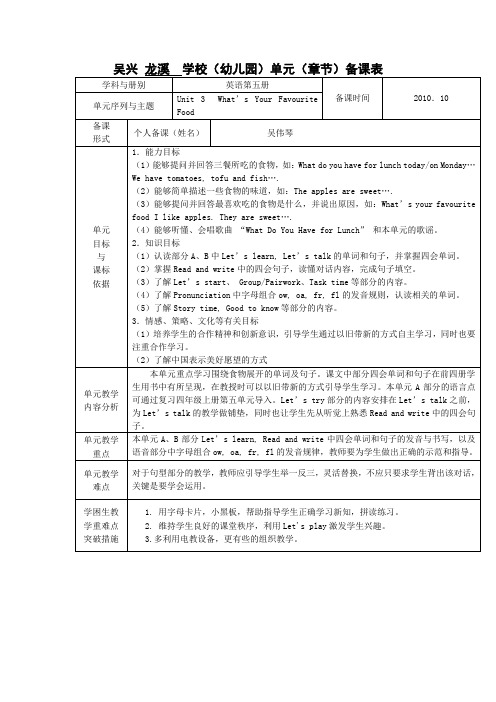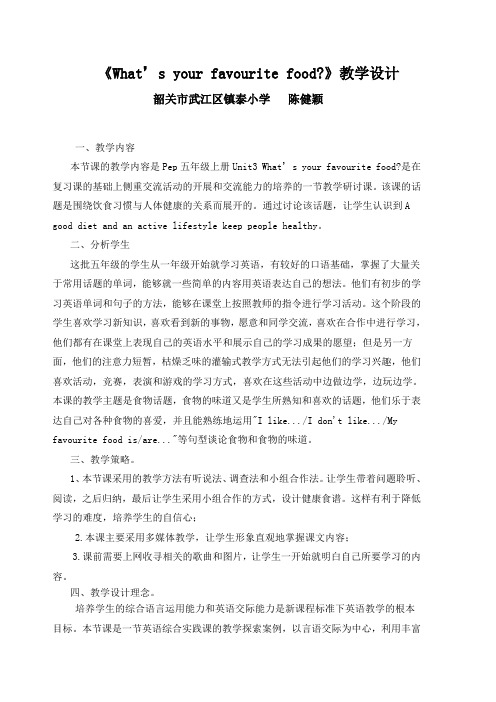unit 3 what's your favourite food 教学设计
- 格式:doc
- 大小:41.00 KB
- 文档页数:2

教学设计11.导入设计(1)Let’s chant.Chant 1 Time for breakfast, drink some milk.Time for lunch, have some chicken.Time for dinner, eat some rice.Time for P.E., jump and run.Time for English, read and write.Time for music, sing and dance.Chant 2 Monday, Tuesday, Wednesday.Thursday, Friday, Saturday.Sunday, Sunday, Sunday.Sunday, Saturday, Friday.Thursday, Wednesday, Tuesday.Monday, Monday, Monday.Today is a fun day, a fun day, a fun day!【设计思路】用两首已学的chant,将学生带入英语学习状态,活跃气氛,缓解学生紧张的情绪,激发他们的学习兴趣和主动性。
同时chant的内容紧密联系本节内容,复习了已学的单词lunch,dinner和一星期各天名称。
(2)Free talk.通过交流日常对话,拉近师生间距离。
Questions: How are you today? What day is it today?How can you spell the word“Tuesday”?Do you like English class? Do you like me?2.新课呈现(1)呈现菜单,引出句型。
将学生分为四组,做石头、剪子、布游戏,利用CAI课件复习食物单词tofu、eggplant、fish、green beans、tomatoes、potatoes、pork、mutton、carrots、cu-cumbers等。


Possible article:Exploring Favorite Foods in Primary English ClassUnit 3 of the primary English textbook asks students to share their opinions about food and learn vocabulary related to different typesof cuisine. In this lesson plan, we will introduce some pedagogical activities that encourage children to talk about their favorite foods, practice basic sentence structures, and develop theircognitive and social skills.Objectives:-To enable students to communicate in English about their favorite foods using simple phrases and expressions-To enrich students' vocabulary and comprehension of food-related terms-To foster students' empathy and tolerance towards different food preferences and cultural backgrounds-To promote students' creativity and cooperation in designing and presenting their culinary creationsMaterials:-The textbook page with Unit 3 topic and vocabulary- A list of food-related questions and prompts-Pictures or samples of various foods (real or virtual)-Recipe cards or templates for a food-making activity (optional)-Feedback sheets for peer assessment (optional)Procedure:1.Warm-up: Food FlashcardsStart the lesson by showing some flashcards or images of different types of food, such as pizza, burger, sushi, noodles, chicken,carrot, apple, ice cream, etc. Ask the students to guess or name the food and tell whether they like it or not. You can also use a 5-star rating system to gather their opinions.2.Vocabulary Practice: Word AssociationUsing the vocabulary list from the textbook, ask the students to brainstorm words that are associated with food, such as taste, smell, texture, ingredients, utensils, cooking methods, etc. Write thewords on the board or on a mind map, and use them to elicit further examples from the students. You can also play a word chain game,where each student has to say a new word that starts with the last letter of the previous word.3.Speaking and Listening: Favorite Foods InterviewPair up the students and give them some interview questions to ask each other, such as:-What's your favorite food? Why do you like it?-Have you ever tried any foreign food? Which one did you like the most?-Do you prefer sweet or salty food? Hot or cold food? Spicy or mild food?-How do you usually eat your favorite food? With whom do you share it?Encourage the students to take turns asking and answering the questions, and to listen actively to their partner's answers. Youcan also provide some sentence patterns for them to use, such as:-My favorite food is ______. I like it because it tastes _______.-I haven't tried ______ before, but I'm curious about it.-I usually eat ______ for _______ meal. I share it with my _______.4. Writing and Reading: Food PoemAs a group activity, ask the students to brainstorm some adjectives that describe different foods, such as yummy, juicy, crunchy, burnt, sticky, sour, etc. Then, model a simple poem structure, such as: (Title) My Favorite Food(Line 1) (Food name) is _______ (adjective).(Line 2) It smells like _______ (noun).(Line 3) It feels _______ (adjective) in my mouth.(Line 4) I could eat it _______ (number) times a day.(Line 5) It reminds me of _______ (memory).Have the students work in pairs or small groups to create their own food poems, using the vocabulary and sentence structures they have learned. You can provide some examples or scaffolding sentences to help them, such as:-Pizza is cheesy and crispy.-It smells like fresh-baked bread.-It feels greasy and hot on my tongue.-I could eat it every day for a week.-It reminds me of my birthday party.5. Project and Presentation: Food FaceThis is a fun and creative art project that also involves some food decoration skills. Give each group a blank paper plate and someedible materials, such as fruits, vegetables, sauces, cheese, bread, etc. Explain that they have to design a face or a character usingthe food ingredients and present it to the class, explaining their choices and creativity. You can use some themes or challenges tomake it more engaging, such as:-Make a healthy food face.-Make a funny food face.-Make a traditional food face from your own culture.-Make a food face inspired by a famous person or character.After the presentations, ask the students to give feedback to each other, using some criteria such as creativity, effort, taste,variety, etc. You can also provide some reflective questions forthem to think about, such as:-How did you feel about making and sharing your food faces?-What did you learn from your classmates' presentations?-Did you discover any new favorite foods or combinations today?-How can you use English to talk about food in your daily life? Assessment:The students' performance can be assessed through various means,such as observation, participation, oral and written tasks, and peer feedback. You can use a rubric or a checklist that includes the learning objectives and some criteria for success, such as fluency, accuracy, vocabulary range, coherence, pronunciation, creativity, cooperation, etc.Conclusion:This lesson plan offers a variety of activities that cater todifferent learning styles and language skills. By exploring thetopic of favorite foods, students can enhance their communicative competence in English, broaden their cultural awareness, and develop their artistic and culinary abilities. Through collaborative and reflective tasks, students can also experience a sense of belonging and achievement in the classroom. The teacher's role is tofacilitate and scaffold the learning process, while encouraging and guiding the students to express themselves and learn from each other.。

《What’s your favourite food?》教学设计韶关市武江区镇泰小学陈健颖一、教学内容本节课的教学内容是Pep五年级上册Unit3 What’s your favourite food?是在复习课的基础上侧重交流活动的开展和交流能力的培养的一节教学研讨课。
该课的话题是围绕饮食习惯与人体健康的关系而展开的。
通过讨论该话题,让学生认识到A good diet and an active lifestyle keep people healthy。
二、分析学生这批五年级的学生从一年级开始就学习英语,有较好的口语基础,掌握了大量关于常用话题的单词,能够就一些简单的内容用英语表达自己的想法。
他们有初步的学习英语单词和句子的方法,能够在课堂上按照教师的指令进行学习活动。
这个阶段的学生喜欢学习新知识,喜欢看到新的事物,愿意和同学交流,喜欢在合作中进行学习,他们都有在课堂上表现自己的英语水平和展示自己的学习成果的愿望;但是另一方面,他们的注意力短暂,枯燥乏味的灌输式教学方式无法引起他们的学习兴趣,他们喜欢活动,竞赛,表演和游戏的学习方式,喜欢在这些活动中边做边学,边玩边学。
本课的教学主题是食物话题,食物的味道又是学生所熟知和喜欢的话题,他们乐于表达自己对各种食物的喜爱,并且能熟练地运用"I like.../I don't like.../My favourite food is/are..."等句型谈论食物和食物的味道。
三、教学策略。
1、本节课采用的教学方法有听说法、调查法和小组合作法。
让学生带着问题聆听、阅读,之后归纳,最后让学生采用小组合作的方式,设计健康食谱。
这样有利于降低学习的难度,培养学生的自信心;2.本课主要采用多媒体教学,让学生形象直观地掌握课文内容;3.课前需要上网收寻相关的歌曲和图片,让学生一开始就明白自己所要学习的内容。
四、教学设计理念。
培养学生的综合语言运用能力和英语交际能力是新课程标准下英语教学的根本目标。

Unit 3 What's your favourite food第一课时教案示例一、学重点:let’s learn部分的单词:tomato,tofu,green beans,fish,potato,eggplant,cabbage,mutton,pork。
在情景中使用对话中的句子,并能恰当的替换句中的单词。
听、说、读、写单词:tomato,tofu,green beans,fish,potato,eggplant。
二、教学难点:词汇量较大,有些单词不易掌握:tomato和potato易混淆;eggplant较长;cabbage 的发音较难;pork 和mutton的意思容易混;tofu的发音容易被中文干扰。
课前准备:教学过程中所需的图片(let’s start)、录音(let’s learn, Let’s chant)、课件、动画素材,以及上课时的九张单词图片和卡片。
教师准备相关媒体的播放设备,如录音机、投影仪、幻灯片等。
三、教学过程:Warm up (热身)教师播放四年级上册第五单元Let’s sing部分歌曲和四年级下册第六单元P73儿歌,学生说唱,复习有关食物单词。
教师播放教材P26 Let’s chant中的儿歌,学生欣赏,帮助学生复习What would you like for lunch?I’d like…的问答。
四、Review (复习)请学生说出学过的有关食物的单词(Say some words about food)。
提问:What would you like for lunch?引导学生用I’d like…回答。
当学生的回答中涉及到单词pork,fish,tomato,potato时,教师要适时拿出卡片,带领学生拼读。
五、Presentation (新课呈现)(1)教师播放let’s learn部分录音,学生听两遍。
教师提问:What would Mike like for lunch?引导学生回答:tomatoes and mutton。

本篇文章将为您介绍小学英语《Unit 3 Whats your favourite food》教案,该教案让小学生学习英语对话表达关于饮食的问题。
该教案适用于小学二年级的学生,旨在培养学生的英语口语能力,让学生学会与他人交流关于饮食的话题。
下面,我们将从教案的背景、教学目标、教材分析、教学策略、教学方法、教学手段、教学步骤、教学反思等方面对此教案进行阐述。
一、教案背景小学英语教育应该从基础的语音及单词开始,逐步提高英语交际能力。
这个教案的背景是中国小学二年级教学班,学生的英语基础还比较薄弱,在学习英语的同时,还要培养学生的口语表达能力。
通过研究小学英语教学大纲和相关学习资料,我发现小学英语教学主要以学生语音、单词、语法为主,而对于口语表达的教学相对落后。
学生容易陷入纯粹的英语语法和单词学习中,而忽略了英语的口语表达能力。
因此,我们应该让学生在学习语音、词汇和语法的同时,注重培养他们的口语表达能力,让他们在日常生活中自信运用英语。
本教案旨在让学生学会与他人交流关于饮食的话题,从而拓展学生的英语交际能力。
二、教学目标本教案的主要教学目标如下:1.学会询问他人关于饮食的问题。
2.学会正确应答对方关于饮食的问题。
3.掌握一些英文词汇,如蔬菜、水果、肉类等。
4.发展学生的口语表达能力,增强他们表达自己的信心。
三、教材分析本教案的教材为小学英语二年级学生用书《英语小猪》第三单元《What's yourfavourite food?》。
本单元教材主要包含以下几个方面:1.掌握基本单词和短语,如eat、food、fruit、vegetable、meat等。
2.学会如何询问他人的饮食喜好,例如“What's your favourite food?/Do youlike vegetables?/Wha t fruit do you like best?”等。
3.学会如何回答问题,例如“I like.../Yes, I like vegetables. I like.../Ilike apples best.”等。
Unit 3 What's your favourite food教学重点询问和回答三餐所吃食物的句型:What do you have for lunch today?I have……教学难点What would you like for lunch?和What do you have for lunch today?的不同用法。
课前准备1.教师准备教学过程中所需要的图片、声音、课件,以及所学食物的单词卡片。
2.教师准备相关媒体的播放设备,如录音机、投影仪、幻灯片等。
3.Good to know部分的挂图。
教学过程Warm-up (热身)复习单词教师播放上节课Let’s chant的儿歌,学生说唱,复习所学食物单词。
教师引导学生围绕What would you like for lunch?进行问答练习。
渗透重点播放本单元歌曲《What Do You Have for Lunch?》,向学生呈现本课教学内容,让学生在欣赏歌曲的同时感知本节课的新语言。
Presentation (新课呈现)教师根据学生的理解情况可再随意说些句子让学生理解What would you like for lunch?和What do you have for lunch today?的不同用法。
以下内容仅供参考:A:I’d like tofu, green beans and cabbage for lunch. But no green beans today.B:What do you have for lunch today?A:I have cabbage and tofu.(3) 启发学生比较What do you have for lunch today?和What would you like for lunch?的不同, 说出What do you have for lunch today?的功能。
Unit 3What’s your favourite food?Part B Let’s learnTeaching aims:1.能够听、说、读、写本课时的四会单词:tasty、salty、sweet、sour和fresh,并认读单词healthy。
2.能够说唱歌谣,并理解其含义。
3.能运用这些单词对实物进行简单描述。
Important and difficult points:Important points: 学习单词tasty、salty、sweet、sour、fresh和healthy,并能运用这些单词对实物进行简单描述。
Difficult points: healthy的发音Teaching aids: 本课时的六张卡片、课件、一个大红苹果、录音Teaching procedures:Step1 Warm up⑴Greetings⑵Let’s chant U2L4 Sunday is sweet for me.Step2 Lead inPresent: sweet fresh tasty healthy①The apples are sweet for me,too.呈现sweet 教授发音规则,拼读、四线格示范和各别读、齐读。
Chant: The apples are sweet for me,too. 跟读,个别读。
②呈现苹果树. The apples are fresh. 呈现fresh 教授发音规则,拼读、四线格示范和各别读、齐读。
Chant: The apples are fresh. 跟读,个别读。
③出示苹果实物并品尝。
The apples are tasty and yummy. 呈现tasty 教授发音规则,拼读、四线格示范和各别读、齐读。
Chant: The apples are tasty and yummy. 跟读,个别读。
④呈现柠檬 Is lemons sour? 呈现sour 教授发音规则,拼读、四线格示范和各别读、齐读。
第六课时教学设计一、教学重点:1.准确理解Read and write对话中的语句,掌握四会句子的书写。
2.掌握字母组合ow,oa,fl,fr在单词中的发音规则。
二、教学难点单词favourite的拼写。
三、课前准备:1.教师准备教学过程中所需要的图片、声音、课件,以及所学食物的单词卡片。
2.教师准备相关媒体的播放设备,如录音机、投影仪、幻灯片等。
3.Group work中的表格复印材料。
四、教学过程:1. Warm –up (热身)说唱歌谣(1)教师播放上节课扩展资料中的歌谣录音:What’s your favourite fruit? …are my favourite fruit.(2)学生拍手说唱歌谣。
(3)接龙说唱活动:教师先用What’s your favourite fruit? What’s your favourite fruit?向任意一位同学提问,被问到的同学用…are my favourite fruit.说出自己最喜欢的水果,然后再问另一个同学,以此类推。
口语练习(1)教师说:I like bananas. Bananas are my favourite fruit. T hey are tasty. What’s your favourite fruit? 启发学生用…are my favourite fruit.说出自己最喜欢的水果,并用所学形容词简单说明原因。
(2)小组活动:每个同学用…are my favourite fruit. They are … 告诉同桌同学自己最喜欢的水果及其原因。
2. Presentation (新课呈现)Read and write(4)教师播放Read and write部分的课件,学生观看,初步感知对话内容。
(5)教师分别指着课件图像中的Monkey,Rabbit,Zoom,Zip问:What’sMonkey’s favourite fruit? What’s Rabbit’s favourite fruit? What’s Zip’sfavourite drink? What’s Zoom’s favourite food?学生带着问题阅读对话,并将以下句子补充完整:_______ are Monkey’s favourite fruit. They’re _______ .________are Rabbit’s favourite fruit. They’re _______ .________is Zip’s favourite. It’s ______ and _______ .________ is Zoom’s favourite food.(3) 教师检查并了解学生完成情况。
Unit3 What’s your favourite food?教案A. Let’s talk一、教材分析本节课是PEP教材小学英语五年级上册第三单元What’s your favourite food?主要学习食物单词和询问进餐的句型。
本节微型课节选于最后的拓展部分,通过创设真实的情景,放学后一起到KFC就餐,让学生运用新学句型进行对话表演,让学生在真实的情景中学会运用新句型。
二、教学背景五年级的学生了,具备了一定的英语基础,同时也具备了评判老师及学生水平的自己的标准。
不能硬性的机械的教授他们英语,要采用活动,还要设定一定的情景,拉他们参加,引他们学懂每一节课的内容。
本节课主要借助于实物,为学生创设情景,使教学内容形象、生动,便于学生理解,并充分调动学生的积极性,使学生在玩中乐中动中学习新知识。
三、教学目标能用本课中的重点句型What do you have for lunch? I have_________.在情境中进行运用。
三、教学重、难点重点:用本课中的重点句型What do you have for lunch? I have_________.在情境中进行运用。
难点:1、句型 What would you like for lunch ?与What do you have for lunch today?的不同用法。
2、培养学生通过所学知识进行有效交际的能力。
教学过程一、Consolidation and extension(巩固和延伸)创设情景:放学了,你和你的朋友相约到KFC吃饭,你会跟售货员和朋友进行怎么的谈话。
三人小组为单位,开展对话。
1.老师跟两同学示范对话形式。
T:Boys and girls . Y ou really did good job today, How many stars did you get? If you got 3 stars, you can take 3 coupons in your group How many do you have? Let’s go to the KFC and have lunch. This time, Three people in a group. One to be the waiter or waitress. Two to be the customers, make a new dialogue, ok? Now I am the waitress, Who want to be the customers?(老师展示对话格式,然后跟两同学做示范)2.三人小组进行对话操练。
教学设计
一、学习内容:
1、关于食物的单词: pork, fish, green beans , cabbages, potatoes, tomatoes, mutton, eggplant
2、关于表达自己喜好的句子:What’s your favourite food? I like… I don’t like …
二、学习重难点:。
1、单词的记忆,以及eggplant ,cabbages, mutton 的读音
2、句子在实际生活中的运用
三、学习准备:
1、教师准备:单词卡片,多媒体课件,关于食物的奖励小卡片若干
2、学生准备:关于食物的图片若干
四、学习过程
(一)导入和热身Warm up and preview
1、日常口语练习
Hello!
How are you ?
Nice to see you.
2、预习
通过多媒体课件快速的展示给学生一些他们很熟悉的关于动物和水果的单词,引出主要句型What’s your favourite food? I like … I don’t like …
(设计思路:①鉴于本节课的内容并不难,所以我将句型放在新单词的前面。
这样一来,通过旧单词练习新句型,在一定程度上降低了学生学习的难度。
②在这个环节中我安排了让学生快看快记的练习,以培养孩子们快速记忆的方法和能力。
)
(二)新课呈现Presentation
1、通过上一个环节的练习和学习,延续学生们的思维,直接进入新知识的学习环节。
(设计思路:本节课的八个单词中,pork potatoes tomatoes fish并不难,所以我并没有把太多的精力放在这些单词上,但是其他四个相对来说孩子们并不熟悉,所以新课的教授过程主要集中在这四个单词的教授和练习上.)
3、Chant
①教师先根据学生的学习情况带领大家进行演唱
Food, food , favourite food.
What’s your favourite food?
Pork ,pork, I like pork.
What about you ? What about you?
②孩子在学习了这个chant 之后,孩子可以用其他的单词进行替换,编出自己的chant Food, food , favourite food.
What’s your favourite food?
_____ ,_____, I like pork.
What about you ? What about you?
(设计思路:孩子对于有节奏的内容往往是记忆比较深刻的,了解了孩子这样的心理特征,我将本节课的主要内容编成了一段孩子们很熟悉也很朗朗上口的chant.让学生学会chant是件很容易的事情,但是要学生通过动脑自己学会编chant并不是件非常容易的事情。
我希望通过这样的活动,训练学生的英语语感和乐感。
)
(三)练习Practise
1、Listen and fill in the blanks
A:What’s your favourite food?
B: I like ________.
A:What would you like for lunch today?
B: I’d like some __________ and ____________.
2、Listen and write a single sentence
A:What’s your favourite food?
B: _________________________________.
A:What would you like for lunch today?
B: ________________________________.
3、Listen and write again
A:______________________________ ?
B: ________________________________.
A:_______________________________?
B: ________________________________.
(设计思路:本课时的单词并不难,所以孩子们应该很快的能够掌握单词的读音和部分单词的拼写,那么我就大胆的尝试看看孩子们单词拼写的掌握情况。
但是也仍然符合孩子的认知规律,由易到难,步步递进。
)
4、Work in pairs and make your own dialogue
A: What’s your favourite food?
B: I like …
A: What would you like for lunch today?
B: I ‘d like some…
(设计思路:紧跟前面的写的环节,因为写的句子正是我们用来编写对话的句子,所以这一环节对于学生来说应该是易如反掌。
)
(设计思路:每个孩子都有自己喜欢的食物,孩子们在一起可以自由的选择自己想吃的食物,这样,他们也会很乐于向大家表达自己的喜好。
)
(四)巩固与延伸Extension and conclusion
1、教会一些简单的的不能一起搭配食用的食物
2、让孩子多吃蔬菜和水果,有益于身体健康。
五、板书设计
Unit 2 What’s Your Favourite Food?
What’s your favourite food?
I like …
What would you like for lunch today ?
I’d like some…。